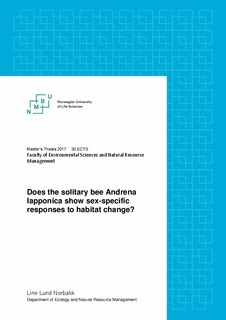| dc.description.abstract | Aim: Land use alterations are a serious challenge for solitary bees. This is especially so for specialized bees that rely on a single plant species when collecting pollen for their larvae. Moreover, the sex ratio within bee populations may change with habitat quality because females are costlier to produce than males. However, gender is a rarely considered trait, and potential sex-specific responses to habitat loss and habitat change are poorly understood. I used populations of the solitary bee species Andrena lapponica as a model organism to test if the spatial and bi-annual (2013-2014yr) variation in population sizes was related to the sex ratio within populations as well as the availability of foraging resources.
Location: Three experimental plots, mimicking different habitat management practices, replicated across 19 power-line clearings in south-eastern Norway. Sampled in both 2013 and 2014.
Methods: I tested if the relationships between A. lapponica abundance and habitat quality differed between male and female bees at the inter-population level. Because bee populations show inter-annual fluctuations, I also tested if differences in the increase in population sizes between power-line clearings were related to habitat quality. Finally, at the intra-population level, I tested if the occurrence of bees differed among three experimental plots, and if this difference depended on habitat quality. The three treatments were: (1) Cut: All trees were cut and all biomass was left to decay in the plot; (2) Uncut: No trees were cut and the plot remained uncleared; (3) Cut-remove: All biomass was removed after cutting.
Results: The sex ratio was female biased, I found no statistically significant difference in habitat use between males and females. The abundance of bees was most strongly associated with V. myrtillus availability, which was the main explanatory variable for presence of bees. The number of bees was four times higher in sites where the level of V. myrtillus was high compared to sites with low levels of V. myrtillus. When including the cut & remove treatment in combination with the high levels of V. myrtillus the probability of observing a bee was high. The likelihood of observing a bee in any of the treatment plots without V. myrtillus was low.
Conclusions: V. myrtillus is the main driver for habitat choice for A. lapponica, but open sites with direct sunlight and a higher probability of appropriate nest sites are likely important as well. To ensure good habitats for ground nesters like A. lapponica it is important to focus on areas that have high food resource levels, but they also need to be combined with open areas with exposed soil or sand resources. For management practices to be efficient, they should ensure and enhance both food and nesting resources for wild bees. Furthermore, the absence of sex-specific responses to habitat change may be due to a short sampling period, as fluctuations in population and sex ratio are normal between years. Longer lasting studies may therefore be necessary when studying wild bees’ sex-specific responses. | nb_NO |

